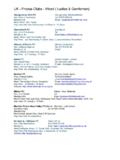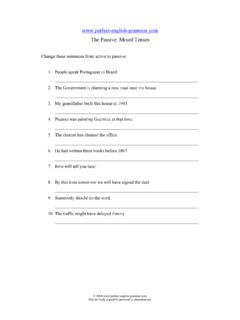Transcription of 374-2008: PROC MIXED: Underlying Ideas with Examples
1 1 Paper 374-2008 PROC mixed : Underlying Ideas with Examples David A. Dickey, NC State University, Raleigh, NC ABSTRACT The SAS procedure mixed provides a single tool for analyzing a large array of models used in statistics, especially experimental design, through the use of REML estimation. A strategy for identifying mixed models is followed by a description of REML estimation along with a simple example that illustrates its advantages. A comparison of some of the available tests for variance components is given along with several Examples , both real and artificial, that illustrate the variety of models handled by PROC mixed .
2 INTRODUCTION mixed models include a wide array of useful statistical approaches, some new and some quite old. SAS PROC mixed uses an estimation method similar to maximum likelihood called REML estimation. This is a relatively new method and with it comes some new looking output similar to the traditional analysis of variance table but with some added features that give useful information related to both traditional models and more interesting cases such as random coefficient models, panel data in economics, repeated measures (closely related to panel data) and spatial data. This paper attempts to provide the user with a better understanding of the Ideas behind mixed models.
3 The first section of the paper explains the difference between random and fixed effects and gives a checklist for deciding which effects you have. mixed models, as the name implies, can have some of each. The next section uses a simple experimental design, the randomized complete block, to investigate the differences between treating block effects as fixed and treating them as random, both in the presence of fixed treatment effects. It includes the definition and computation of so-called BLUPs and the intraclass correlation coefficient. The next section formalizes the general mixed model and reviews the concept of REML versus maximum likelihood (ML) estimation.
4 ML (maximum likelihood) and REML are compared in the context of the randomized complete block design. Following this a discussion of several suggested tests for the presence of random effects is given along with a small Monte Carlo study comparing these in the context of a randomized complete block design. In the next section an unbalanced data set with random and fixed effects is shown and analyzed in both PROC GLM and PROC mixed for comparison purposes. The paper ends with a random coefficient model using a study on activity levels in bears. RANDOM OR FIXED? Imagine a clinical trial involving doctors within hospitals.
5 Each doctor has 3 patients with a certain disease and assigns then to drugs O (old) N (new) and C (control) at random, one patient for each drug. Now if there is a fourth drug, the researcher surely could not say anything about the performance of this new untested drug based on the results for the other three. On the other hand, the readers would be quite disappointed if the researcher found the new drug better than the old but then stated that this only holds for the 20 doctors (from 4 clinics) used in the study. Unless one of them is my doctor I have no interest in such a result. Nevertheless there may be a doctor effect so that the researcher needs to include doctor as a source of variation.
6 One possibility is to imagine the doctors (and clinics) used as a random sample from a population of doctors (clinics) whose effects are normally and independently distributed with some doctors having effects less than average and some more than average. It would then be only the variation in the doctor effects that would be of interest and the reader would, as with any sample, assume that inference was for the population of doctors from which the researcher sampled. In this example drugs are fixed effects while doctors and clinics are random effects. I present, below, a table that I use as a checklist to distinguish fixed versus random effects.
7 Going through this checklist one thinks of doctors as being a random sample form a larger population, though often true randomization and sampling from a complete list of doctors is not actually done. The same applies to clinics. In contrast, the drugs were no doubt selected because they were the only items of interest. SAS is the registered trademark of SAS Institute Cary, Statistics and Data AnalysisSASG lobalForum2008 2 RANDOM FIXED Levels selected at random from conceptually infinite collection of possibilities finite number of possibilities Another Experiment would use different levels from same population would use same levels of the factor Goal estimate variance components estimate means Inference for all levels of the factor ( , for population from which levels are selected)
8 * only for levels actually used in the experiment* (* an exception is when Y has a polynomial relationship to some X - usually X would be considered fixed even though the polynomial can predict at any X) In row 2 of the table, suppose a researcher from another state saw the results and wanted to replicate the experiment. This new experiment would surely use the same drugs if it were a true check on the first experiment, but would likely use a different sample of clinics and doctors (from the same large population). While the supervisor of the clinic may be interested in specific doctor means and an insurance company might be interested in clinic means, the nature of the experiment as described does not focus on means but rather simply admits that there are variance components for the doctor and clinic factors and estimates these variance components.
9 On the other hand, direct comparison of drug means is surely of interest here. This illustrates the line of the above checklist labeled Goal . Finally there is the issue of the scope of inference. As stated above there would be no thought that this experiment would inform the reader about an untested fourth drug, but surely the scope of inference for doctors and clinics should extend beyond just the 4 clinics and 5 doctors per clinic used. example 1: Using some made up data for illustration, here is a run with PROC mixed . Here we look at twins from 20 families. We train one twin in SAS programming using method A and the other with method B.
10 At the end of the training we give a programming task and record the time it takes to come up with a correctly running solution, this being our response variable TIME. This experiment can be thought of as a randomized complete block design with families serving as blocks, or equivalently, a paired t test with twins paired up by families. The treatment is the training method. Figure 1 is a plot with labels indicating training method, family number on the horizontal axis and programming time on the vertical axis. Figure 1: Programming Times Our data set needs variables FAMILY, TWIN, METHOD, and the response variable TIME.















